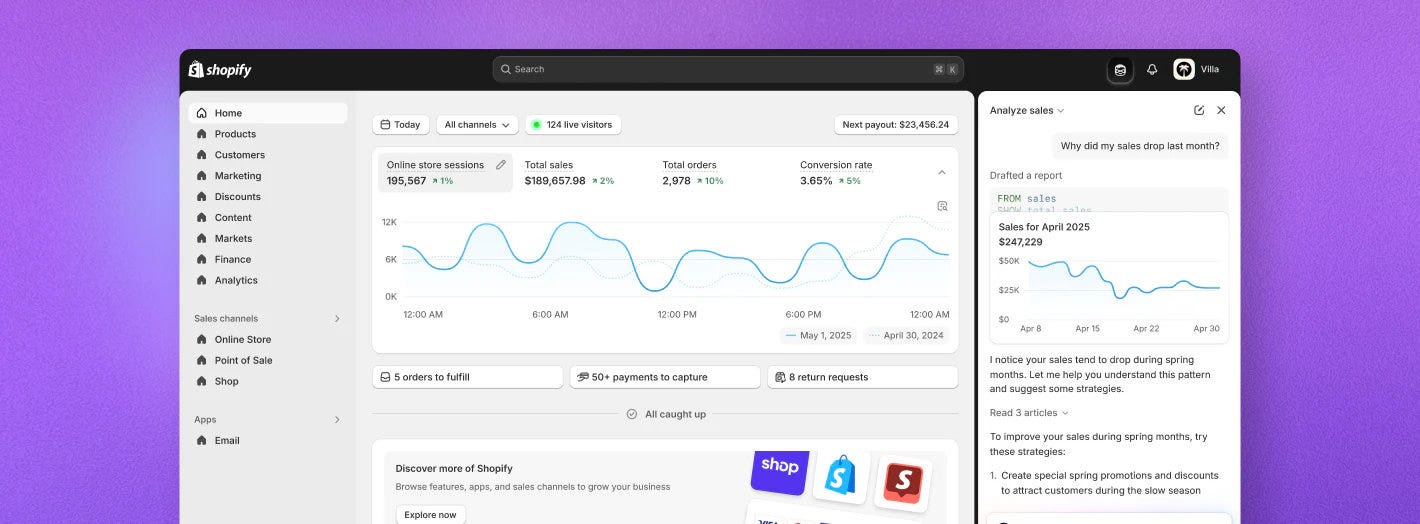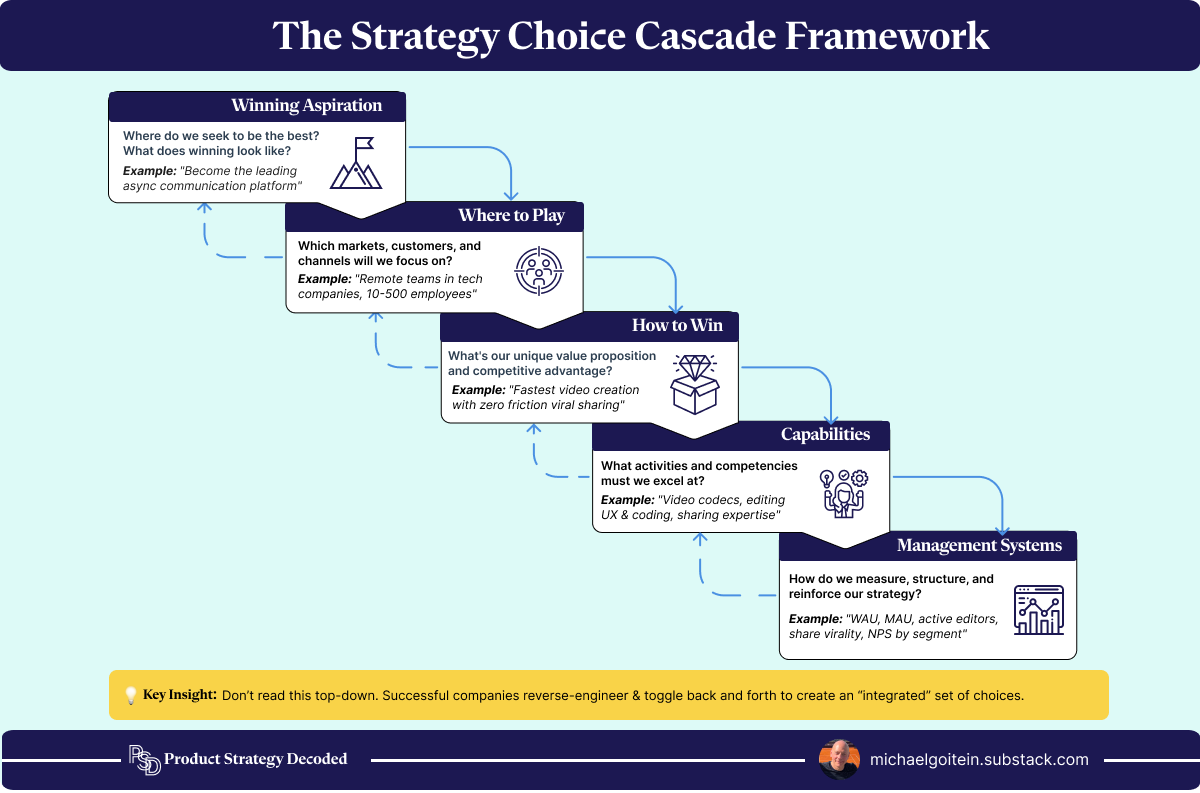How Shopify's AI-First Mandate Turbocharges Its Already Unbeatable eCommerce Strategy
While competitors bolt on AI features, Shopify uses AI to eliminate entire categories of work, creating speed advantages that compound faster than rivals can respond
🎯 My goal for the next 12 months is to help you become a 50% more strategic leader, with at least a 20X return on investment through exclusive case studies, proven frameworks, community insights, and direct access to strategic thinking that drives real business results.
As part of Product Strategy Decoded, you’re able to:
Think strategically, not just tactically – Transform from someone who executes orders to someone who sets the strategic direction, with frameworks and mental models that help you connect the dots from strategy through execution.
Join a community of strategic practitioners – Get access to our subscriber-only community chat where fellow strategic leaders share real-world applications, challenges, and wins from implementing these frameworks.
Stay ahead of the curve – Receive subscriber-only deep dives, live strategy breakdowns, and occasional webinars where we tackle the most pressing strategic challenges facing today's leaders.
The tech press thought Shopify's 2025 "prove AI can't do it before hiring" mandate was a call for them to become an AI-first company.
They missed the point entirely.
Shopify CEO Tobias Lütke isn't interested in becoming the next OpenAI. He's weaponizing AI to accelerate competitive advantages that BigCommerce, Adobe Commerce, and WooCommerce already can't match.
While those companies scramble to add AI features, Shopify eliminates merchant setup time from months to hours, automates ecosystem partner support, and turns customer success into a self-reinforcing competitive moat.
The result: AI is enabling Shopify to compound its strategic advantages faster than competitors can respond.
Shopify’s AI Advantage to the Rescue

Launch day was supposed to be her triumph. It nearly ended in disaster.
Shari Gail Chua had spent months crafting the perfect launch strategy for Softlife Sleepwear, her premium cotton and bamboo pajama line.
She'd built a devoted following through authentic storytelling, sharing her design journey, and gathering feedback on materials, color, fit, patterns, long before her Shopify store went live.
When eager customers couldn't complete checkout, they flooded her inbox with complaints. Orders were abandoned. Months of careful audience-building started evaporating in real-time as frustrated fans were giving up and going elsewhere. On any other commerce platform, this would have meant frantic support tickets, days of back-and-forth troubleshooting, and potentially catastrophic loss of reputation and revenue.
But Shari Gail turned to Shopify's "Sidekick" AI assistant. In minutes, she discovered the problem: she'd forgotten to disable payments test mode.
One click rapidly fixed what could have been a lengthy, business-ending crisis.
Things Get Better… Then Worse…
Plot twist: her quick recovery now created an even bigger, although much higher-quality, problem.
Her committed fanbase flooded her site so hard that she sold out her entire seasonal inventory in a single week. Again, Sidekick came to the rescue, analyzing which colors, styles, and sizes to restock first based on data from her first batch of orders, cross-referenced with thousands of similar stores. What would have been guesswork became confident, data-driven reordering from her supplier.
What might seem like Shari Gail's "lucky" recovery was the result of a series of Shopify’s strategic choices in action.
The Waymo Advantage in a Manual Transmission World
Think of it like this: while BigCommerce and WooCommerce customers are still grinding gears in old, clunky manual transmission cars, Shopify hands its shop owners fully autonomous, self-driving Waymo cars.

You might enter the same destination into both vehicles, but the driving experience couldn’t be more different.
While Shari Gail was solving her checkout crisis in minutes, sleepwear competitors on other platforms were still panicking as they waited for human support responses. That speed and stress differential speaks to the core of Shopify's competitive advantage.
Untouchable
The same AI infrastructure that saved Shari Gail's launch also auto-generates product descriptions in 30 seconds, creates images on the fly, predicts inventory needs, and optimizes checkout flows based on millions of similar stores.
This is Shopify’s AI-as-strategy in action. Nothing screams "AI," but under the hood, nearly every key e-commerce business operation runs at 10X speed.
But how did Shopify engineer this AI-powered competitive advantage? And more importantly, how can you apply these same principles before your competitors catch on?
To decode the choices enabling Shopify's success, we’ll reverse-engineer them using Roger L. Martin's "Strategy Choice Cascade" framework.
Reverse-Engineering Shopify's Strategic Superiority
Winning Aspiration: Merchant Empowerment vs. Platform Control
For Shopify, "winning" means democratizing commerce by empowering entrepreneurs to own their businesses.
Unlike Amazon's "own the customer" model, Shopify wins when merchants control their customer relationships and independent commerce thrives over centralized platforms.
This distinction matters immensely.
Amazon aspires to be the everything store. Shopify aspires to empower merchants to the point that neither they nor their customers will ever need Amazon again.
Where to Play: The Anti-Amazon Strategy
Shopify serves everyone, but focuses on growth-stage businesses ($100K-$50 revenue) who value brand ownership over traffic acquisition.
Operating across 175+ countries, Shopify’s sweet spot is merchants building omnichannel businesses across web, retail, social, and B2B channels.
More importantly, here's where Shopify explicitly refuses to play:
No enterprise ERP competition with SAP/Oracle
No consumer marketplaces meaning it will never become Amazon
No low-margin sub-$50K merchants who can't afford platform fees
No data monetization, as merchants own their customer relationships
No financial services beyond basic payment infrastructure
Some might see these as missed opportunities.
But for Shopify, these choices represent intentional strategic focus that sustains unshakeable merchant trust. Because where other competitors might see an opportunity to make money by competing with their own customers, Shopify has drawn a line in the sand and refused to.
The credibility gained by that choice alone is worth billions.
How to Win: AI-Accelerated Ecosystem Orchestration
Shopify's advantage comes from making complex commerce simple through three reinforcing elements:
Merchant-Centric Model: Shopify provides infrastructure, but not competition. Merchants own their brand, data, and customer relationships, all things Amazon keeps for itself.
Speed-to-Market Acceleration: AI compresses merchant setup from months to hours. It's like the difference between building a house with hand tools versus using 3-D printed components and robotic equipment. Shopify merchants are already stocking their shelves while competitors are still trying to figure out where to dig the foundation.
Ecosystem Orchestration: Shopify's 8,000+ app ecosystem works like a Swiss Army knife designed by a thousand different tool specialists. Instead of getting a so-so corkscrew, you get best-in-class tools for each specific job, all engineered to work perfectly together.
Shopify's 2025 AI-first mandate accelerates all three advantages:
Merchant Success: AI turns customer achievement into platform network effects
Speed-to-Market: AI eliminates setup bottlenecks
Ecosystem Coordination: AI automates partner support
Capabilities: The Integration Advantage
Shopify's capabilities work like a Formula 1 pit crew, with each piece of equipment and each specialist perfectly tuned to orchestrate a tire change in 2.3 seconds flat.
Competing pit crews, meanwhile, are still scrambling to jack the car up:
AI-Powered Operations: Tools like Sidekick eliminate entire categories of manual work, from store setup, to customer support, and beyond, to sophisticated analytics and operations.
Real-Time Ecosystem Coordination: Like a conductor conducting a symphony where every musician plays their own instrument but follows your every cue, Shopify uses AI to coordinate thousands of specialized apps without needing to own or control any of them.
Global Commerce Simplification: The same tax, currency, and compliance automations that enterprises pay Oracle millions for, delivered at Small- to Medium-Business (“SMB”) price points.
Unified Commerce Platform: Shopify boasts a single backend for online, retail, social, and B2B selling with real-time inventory and customer management.
Management Systems: Where Strategy Meets Execution
Here's what separates Shopify from platforms that just talk strategy: they've built internal systems that turn merchant and partner success into their primary competitive weapon.
While competitors optimize for their own metrics, Shopify plays the long game to boost its entire ecosystem by intentionally optimizing for both merchant and partner wins.
Merchant-First Metrics: While competitors obsess over user engagement, Shopify tracks bottom-line business impact metrics: Merchant revenue growth, retention, and expansion. Whenever merchant success conflicts with platform revenue, Shopify chooses to let merchant success win because it will share that success over the long term.
AI-First Culture: Tobias Lütke’s hiring freeze in favor of AI might seem like cost-cutting, but it's really a forcing function to accelerate Shopify’s capabilities that compounds daily.
Ecosystem Health Monitoring: Shopify tracks partner revenue and app adoption with the same intensity most companies reserve for their own KPIs. Shopify knows that when its partners succeed, everyone wins.
Feedback-Driven Development: Product decisions are centered above all on merchant Gross Merchandise Value (“GMV”) impact, not internal roadmaps. This creates a customer-centric innovation engine rather than sales-led features.
The Alchemy of Shopify’s Strategic Chain Reaction
Here's how Shopify's choices create unbreakable competitive advantages:
Their winning aspiration (merchant empowerment) drives where they play (growth-stage businesses that value full ownership), which determines how they win (AI-accelerated platform and ecosystem orchestration), which requires specific capabilities (engineering expertise and ecosystem coordination), which demands merchant- and partner-first management systems.
It's a strategic domino effect where each choice makes the next choice inevitable. But competitors can't knock over that first domino without rebuilding their entire business model.
It’s Not Just the Platform
Replicating Shopify's strategy would be like trying to outdo Disney World by building better rides.
It's the end-to-end, character, and immersive integrated experiences throughout the parks that make every part reinforce every other.
The companies that implement AI-as-strategy now will leave competitors scrambling to catch up.
The companies that wait will find themselves explaining to customers why basic tasks still take weeks instead of minutes.
Three Counterintuitive Principles You Can Steal Today
Now that we've reverse-engineered Shopify's strategic choices, here are three counterintuitive principles you can apply to your own business, regardless of industry.
Principle #1: "AI-as-Strategy, Not AI-as-Feature"
The Shopify Innovation
Lütke’s radical next-generation "AI-first, human-second" mandate went far beyond cobbling together "AI features," and continues to create a fundamental competitive advantage where AI disappears into the background, silently removing friction from every routine operational task.
Why This Creates Uncopiable Advantages
Speed Asymmetry: AI-powered merchant setup compresses time-to-market from months to hours, creating insurmountable time-based advantages.
Cost Structure Revolution: While competitors still hire humans for routine tasks, Shopify automates them, creating clear cost advantages.
Capability Compounding: AI capabilities continue to improve exponentially while human capabilities improve only linearly. Early movers gain accelerating advantages that make them increasingly difficult to catch up to.
Cultural Transformation: AI fluency becomes mandatory for all employees, creating an organization that thinks and operates differently from competitors.
How to Apply This Strategic Principle
Audit Your Work: Separate uniquely human relationship-building tasks from potentially automatable routine operational tasks. Target repeatable operations to free your people up for creative, strategic, and relationship-focused work.
Implement AI-First Hiring: Before any new hire, require managers to document which AI tools they evaluated and why they failed for that specific role.
Redesign Around AI Capabilities: Go beyond automating existing processes and redesign processes from the ground up around what AI does best. Shopify doesn’t robotically recreate human store process setup; they eliminate almost every setup step entirely.
Strategic Question: What would your competitive positioning look like if AI handled 80% of your operational work?
While AI acceleration gives you speed advantages, the next principle creates network effects and scale advantages that are nearly impossible to replicate.
Principle #2: "Ecosystem Orchestration as Core Strategy"
The Shopify Innovation
Most companies treat partner ecosystems like distribution or marketing channels.
But Shopify treats ecosystem orchestration as a core strategic capability, something that creates differentiation and widens its competitive moat.
Traditional Approach:
Build features → Create partner program → Hope for adoption
Shopify's Approach:
Design ecosystem success → Build platform infrastructure → Let partners build the features.
This means Shopify's product team spends more time on partner success tools than on merchant-facing features.
Shopify knows that winning requires making its ecosystem more attractive and mutually successful than any competitor's ecosystem.
Why Ecosystems Beat Features
Think about it this way: Shopify’s competitors can copy any individual feature they build. But replicating an ecosystem of this magnitude?
That's like trying to rebuild Amazon's delivery network in your garage. While theoretically possible, it’s practically impossible. Your competitors can copy individual features like delivering a package, but replicating the entire ecosystem would mean building logistics hubs, vehicle fleets, fulfillment software, and an army of trained drivers.
Roger L. Martin calls this the "Can't/Won't" test for sustainable competitive advantage. Other e-commerce platforms might add a few apps, but the sheer magnitude of building an ecosystem of this size and sophistication would require fundamental business model changes most companies simply can't or won't make.
How to Apply Ecosystem Orchestration
Measure Partner Success, Not Integration Metrics: Track partner revenue growth and profitability, not the number of partners or your API call volumes. When partners consistently make money, they build better applications and continue to support better integrations.
Invest in Partner Infrastructure: Allocate engineering resources to partner success tools, including dashboards, onboarding automation, and co-marketing platforms. Make it easier for partners to succeed than to fail.
Create Partner-to-Partner Network Effects: Design your ecosystem so partners make each other more valuable, like the thousands of Shopify apps that integrate with each other. This creates switching costs that individual features never could.
Strategic Question: Could competitors replicate your product features (probably yes) or the full might of your ecosystem's interconnected success (much harder)?
Practical Application: Instead of building your next product feature, build the infrastructure that lets partners build that feature better than you could, and make sure partners have everything they need to succeed.
Here's the reality: While you're building features, your smartest competitors are building ecosystems. By the time you realize the difference, they'll have accumulated massive network effects you can't touch.
Building an ecosystem builds a sustainable advantage, but this final principle turns customer success into an offensive weapon.
Principle #3: "Customer Success as Network Effect Strategy"
The Shopify Innovation
Too many companies treat their customer success team as a cost center..
Shopify has turned customer success into a pillar of its competitive strategy, where each merchant's success literally creates network effects that make the platform more valuable for all other merchants.
The Shopify Merchant Success Flywheel in Action
Picture this strategic cycle:
Successful merchants inspire more entrepreneurs to start businesses
More merchants attract more app developers to build tools
Better apps make all merchants more successful
Merchant success stories become Shopify's primary sales and marketing engine
This means Shopify's customer success team isn’t just preventing churn.
Every customer success story widens its competitive moats.
How to Apply "Customer Success as Strategy"
Design for Customer Virality: Structure your business to automatically attract more customers through customer success. HubSpot's customer marketing success attracts more customers AND makes existing customers more successful through community learning.
Create Success Interdependency: Make customers more successful when other customers succeed. Microsoft’s success with Teams in the Enterprise has created demand for increasingly more Teams users, benefiting all customers through network effects.
Measure Network Impact: Track how individual customer success affects overall platform value, not just individual account metrics.
Strategic Question: Are you simply making one-off customers successful? Or are you making customer success strategically advantageous for your business model?
The companies that crack this code first win everything. Customer success as a strategy creates self-reinforcing advantages that compound daily. Your competitors are already experimenting with this approach through testimonials and case studies. The sooner you get started, the better.
The New Rules of Strategic Competition
Contrary to popular opinion, great strategy has little to do with building “better” products alone.
It's about designing ecosystem-based business models where customer wins automatically become company wins, and vice versa. Shopify's genius lies in recognizing and relentlessly obsessing over its merchant- and partner-first business model.
The companies moving fastest to design systems that link customer and partner wins to company wins are already building the hard-to-copy competitive advantages that pure product innovation never could.
The question isn't whether this approach works. The question is whether you'll implement it before your competitors do.
Your strategic challenge: Can you redesign your business model so that your greatest competitive advantages compound from your customers' greatest successes?
Time to Move
The sand is running through the hourglass.
While others debate the “perfect” strategy, your smartest competitors are already building these advantages into their platforms, products, and tools.
The question isn't whether this approach works, but whether you can implement it before your closest competitor does.




